Game name: Apex Legends
Release date: February 4, 2019
Price: Free to play with cosmetic microtransactions (skins and lootboxes)
Available on: Origin
Genre: Battle royale
Developer: Respawn Entertainment
Publisher: Electronic Arts
Opencritic: Here
Launch trailer
If two weeks ago you told me that I’d spend the next few days non-stop playing a battle royale game published by EA, I’d have laughed, and pointed you in the direction of the nearest insane asylum. That’s how surprised I was by Apex Legends, Respawn‘s answer to the PUBG–Fortnite craze. But enough with my reaction to Apex Legends’ announcement and stealth release. Is it any good? Does it bring a revolution to the battle royale genre, or is it a clever evolution of the concept popularized by PLAYERUNKNOWN’S BATTLEGROUNDS? Read on to find out.
Upon starting Apex Legends for the very first time, we’ll be prompted to complete a short (but detailed) tutorial designed to acquaint us with a few key features that aren’t exactly common in similar shooters. The first of such features is none other than the revelation that Respawn‘s first dig at the battle royale genre also includes hero shooter elements, as we’ll have to get to grips with our currently selected Legend’s abilities before we can end this tutorial level. Legends are Apex Legends‘ answer to Overwatch‘s Heroes, and once we load up into a real match, we’ll be able to pick one from a pool of up to eight (two are locked at the start, and can be unlocked with real money or a currency that we earn as we level up. I was able to unlock both characters upon hitting level 44). These Legends are distributed into several categories, and each of them has a passive ability, an active ability and an ultimate ability, which can range from simple things such as being able to summon a fragile shield while aiming down sights, to being able to call an orbital strike from above, or summoning a supply drop that contains useful defensive gear, for example. Currently, the game only lets us play in the Squads mode (which involves groups of three people), and as such, when we are in the Legend selection screen at the beginning of each match, we can lock our preferred character, provided our teammates haven’t beat us to the punch (teams can’t have multiples of a specific Legend). Crucially, all of the currently available characters feel balanced, and the only thing setting them apart from each other are their abilities, as their health pools and movement speeds are the same. Another interesting choice was making all the Legends easy to identify from a distance, so seasoned players can know what to expect from foes even before engaging them, and their silhouettes are also perfect for visibility, something that can be a problem in other realistic-looking titles like PUBG, Blackout or Ring of Elysium.
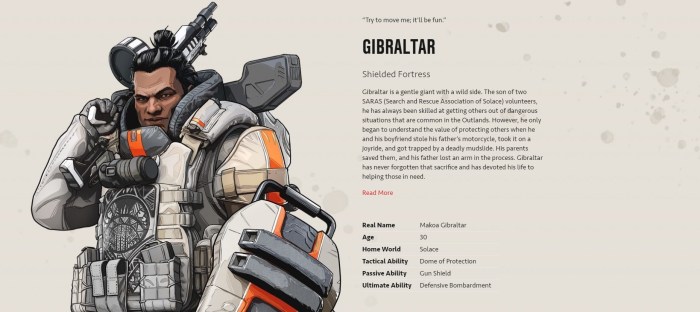
Like most battle royale games, your regular Apex Legends match will start with all the players in a dropship, cruising over a relatively big and open area dotted with named locations full of loot that can be used to pump the competition full of lead. Upon choosing a destination, our squad will fly over there assisted by rocket boosters attached to their backs, land on whatever area has been chosen, and frantically start looking for equipment that can be used to eliminate the opposition. Unlike the other battle royale games I’ve played, Apex Legends handles this initial drop in a very cool way, selecting a squadmate as the “Jump Master”, which means this person will control the whole squad as a single unit until the other people in the group decides to split up. No more “hey, we are going to Pochinki, let’s meet up on the green house over there”- “which green house, that one?”- “no, THAT one!” moments. This also means that playing with random squadmates is easier than usual, as even without a mic we’ll be able to drop at the same location with ease, thus ensuring that early game fights will be supported by the rest of the squad.
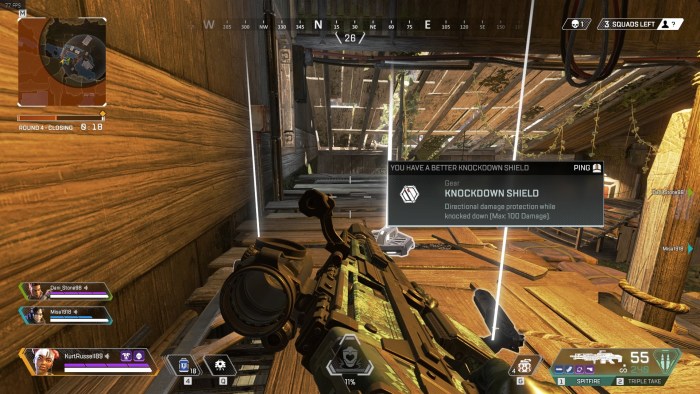
This “Jump Master” system isn’t the only mechanic that helps with the whole “play with random teammates” thing. As the game’s mandatory tutorial will teach us, Apex Legends also incorporates a great ping system, which lets players mark locations in the world with different messages. For instance, if we see something like ammunition, a cool weapon, item or attachment that we already own (or do not wish to pick up), we can simply press the middle mouse button while pointing at it, and our character will call out the name of the object we highlighted, leaving a mark on the world that can be seen by our other two squaddies, and should one of them click their middle mouse button on our mark to call dibs on the item we just shared, they will get a permanent mark that will stay until they pick it up. Enemy callouts are handled in a similar way, and we can even select messages such as “I’m watching this area” with a simple button press. It’s all very intuitive and after just a few minutes of playing with this system, I couldn’t help but think how weird it was that until Respawn decided to create it, no one else had thought about a similar idea for PUBG or Fortnite, for example.
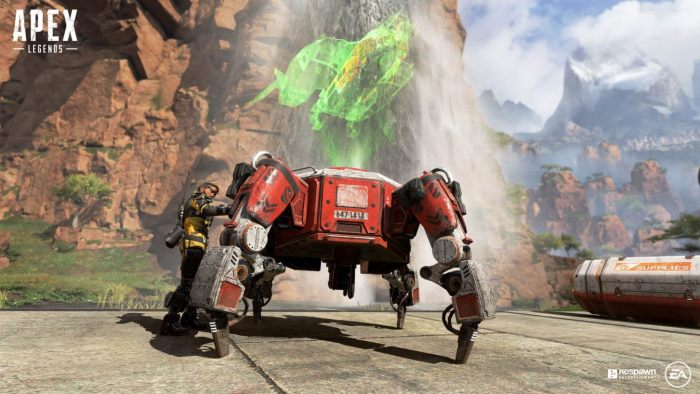
Aside from the two great systems we just described, Apex Legends introduces another mechanic that players have been asking for ever since PUBG first lit the Steam charts on fire: the ability to respawn fallen teammates after they’ve been put out of their misery by enemy fire. Yes, you read that right, Apex Legends lets us collect chips off our dead (truly dead, transformed into boxes, that kind of dead, not just down but not out) teammates and cash them in at specific respawn points that will bring back our squaddies, completely naked as if they’d just joined the game, but alive and able to continue playing the same match. This is huge for seasoned battle royale players. You wouldn’t believe the amount of times my friends and I had to suicide in PUBG so we could get back to playing with a full squad. Apex Legends matches are noticeably shorter than PUBG ones, but having to spectate someone for 10+ minutes is still not exactly a fun proposition, so the addition of this respawn system is a real game changer. Of course there are some restrictions (the chips expire after a minute and a half if they aren’t picked up, and respawn stations aren’t exactly everywhere), but on the whole, this mechanic alone would give the edge to Apex Legends for me and my crew.
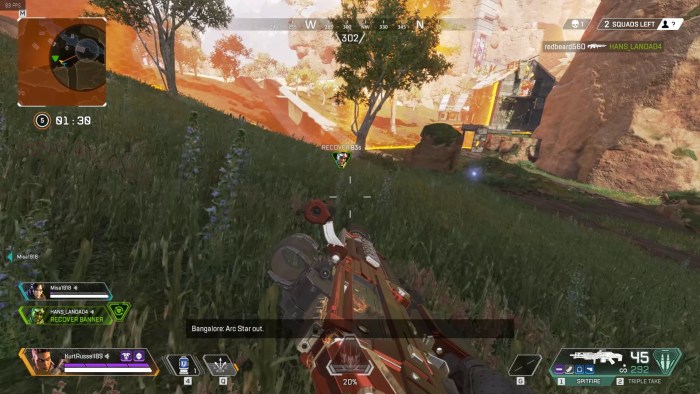
But of course all of these new systems wouldn’t really be worth a lot if the rest of the game wasn’t up to par. This is a first person shooter after all, so we should talk about the movement, gunplay and map design, at the very least. First of all comes movement, which, as it’s based on Titanfall 2, is quite smooth and conveys an appropriate sense of speed, making terrain traversal a joy, even if the game currently does not feature any sort of vehicles other than the jet boosters strapped to our characters’ backs. Wall running and double jumping didn’t make the cut, but crouch sliding and mantling are still in, letting us pull off all sorts of crazy stunts as we move down slopes or try to scale rooftops. Going prone isn’t a thing here either, removing the chance of coming upon a team of pesky campers sitting on tall grass as we try to make our way to the next safe zone. Another great design decision is that there is no fall damage, so we can jump from heights that would normally kill us in other battle royale games without feeling a thing. This lends a sense of unparalleled speed and momentum to the game, as teams can now quickly adjust their position without having to worry about being able to descend from their carefully selected sniping perches, for instance.
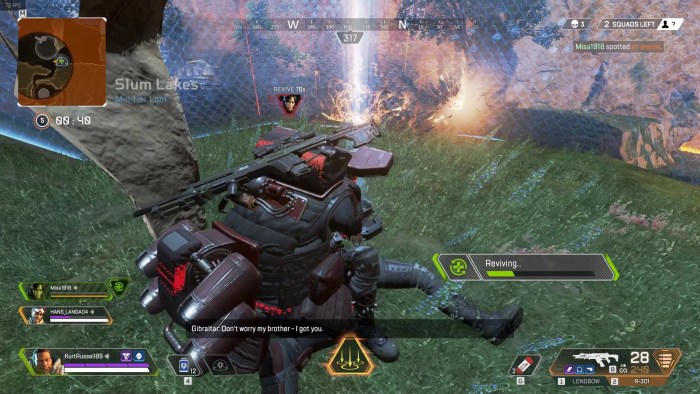
The game’s gunplay is similarly excellent, as it was also lifted almost directly from Titanfall 2. We have a selection of pistols, submachineguns, shotguns, assault rifles, and long range weaponry that could give PUBG‘s arsenal a run for its money. All of these tools of destruction come with their own ammo types (which are handily color coded so we don’t end up with the wrong ammo in our backpack) and attachments that improve different stats such as handling or even add new capabilities to our weapons, like a fire mode selector that turns a specific burst-fire submachinegun into a full–auto beast. Oh, and the best part about these attachments? They get auto equipped on any weapons that can use them if we pick them up, so there’s no more “do I need this, and do I have the space to pick it up?” nonsense. Should we run across better equipment, the game will inform us of this, and automatically drop the outdated attachment upon picking up its replacement. Of course, as Apex Legends is a battle royale game, we’ll also have to contend with defensive items such as body armor and helmets. Interestingly, in this game the armor doesn’t break the same way as it does in PUBG or Ring of Elysium, and we can “top up” our defensive equipment with consumable items instead of having to scavenge for new protection. Grenades are also a thing, coming in three varieties so we can explode our opponents at our hearts’ content.
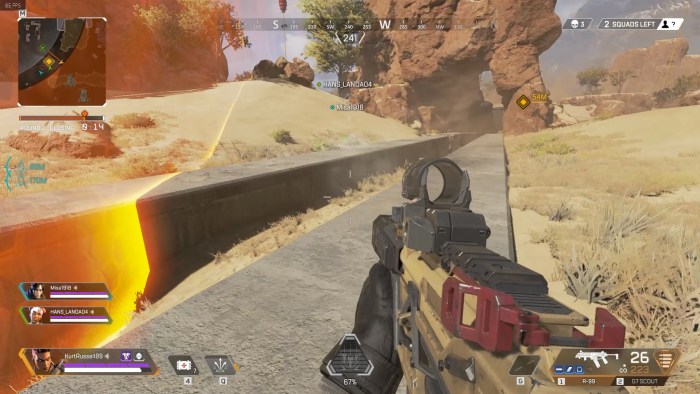
Finally, it’s time to talk about map design, yet another area where Apex Legends excels at. Size-wise, the map is similar to PUBG‘s Sanhok environment, as it’s neither too big nor super cramped, lending itself to a great balance between firefights and moments of calm. Since the player count per match is smaller than PUBG or Fortnite‘s (those games are played by up to 100 contestants per match, while Apex Legends supports up to 60), we can actually have a few minutes of tranquility should we choose to land on the outskirts of the playable area, though this will also probably mean that our gear won’t be the best once we engage players who dropped into hot zones and have already amassed a few kills. As usual with battle royale games, the playable area shrinks every few minutes, and we should always try to outrun an ominous wall of death that will deal damage to anyone caught outside. Loot drops will land from the skies from time to time, acting as a sort of beacon for loot-happy squads that might gain an edge from powerful drop-exclusive special weapons or armor, and there are a few supply ships flying around the place, which also offer high end loot for anyone crazy enough to board them. As we said previously, there are no vehicles, but should we need to cover a large distance quickly, we could make use of special points marked by hot air balloons, where we can sort of redeploy our jet thrusters, flying around for a limited time in order to get ahead of the point, for instance. Visually, the map looks like a mix of different places from the Titanfall universe, with shanty towns, artillery bases and even a Mad Max-inspired thunderdome that can be a great place to end a match.
So far, I’ve been one hundred percent positive about this game, something that has managed to impress even myself, as after playing almost a thousand hours of PUBG, I didn’t think a new battle royale could leave such a lasting positive impression on me. Sadly, there is one aspect of Apex Legends that could use a fair amount of work, and it’s its approach to monetization. Right now, the game relies on both a store that sells different weapon/character skins (or banners that can be used to customize how our character looks in a few screens, or if they are featured as the Champion once the game starts, a cool mechanic where everyone gets to see a winning squad from the previous match in giant banners strewn across the land) and lootboxes, a mechanic that I’m not exactly in favor of, though, to be fair, Apex Legends at least tells us the chances we have to get an item of each rarity. Up to level 10, we get a lootbox for each level up, then up to 50 we get one every two levels, and from then onwards, we get one every five levels. We can also choose to buy said lootboxes from the ingame store (using a currency that can only be acquired with real money). Aside from the lootboxes or the ingame store that features a number of items every few days, the only way of getting a specific skin, banner, pose, voice line, etc. is to craft them with yet another currency that only comes from the lootboxes. If you are unlucky like me, you might never get enough of that currency to craft a high end skin, and thus be forced to buy lootboxes or wait for the skin you want to be featured on the store. And even then, there’s another caveat, which is that most skins cost upwards of eleven dollars, with the high end ones going for 1800 units of currency (which end up converting to about 16-17 USD). This isn’t exactly cheap, and it definitely rules out impulse purchases, something that can be a good thing for us customers, in a way, but may end up affecting the game on the long run.
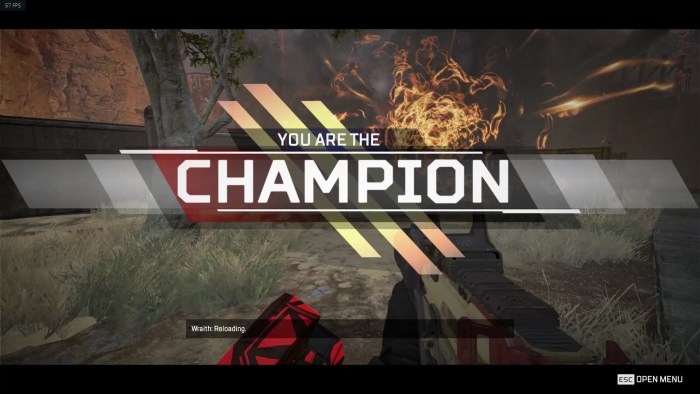
Still, even with these few caveats out of the way, Apex Legends is the most polished and entertaining battle royale to date, smartly evolving the genre in many ways, while at the same time delivering an unparalleled experience that will leave players eager for more and more time with the game. That this was achieved by a free to play game in an universe where a massive AAA behemoth such as Call of Duty delivered the ultimately underwhelming Blackout mode for US$30-60 is an incredible achievement on its own, and a testament to Respawn Entertainment‘s talent and dedication.
9.5/10 – Excellent.


